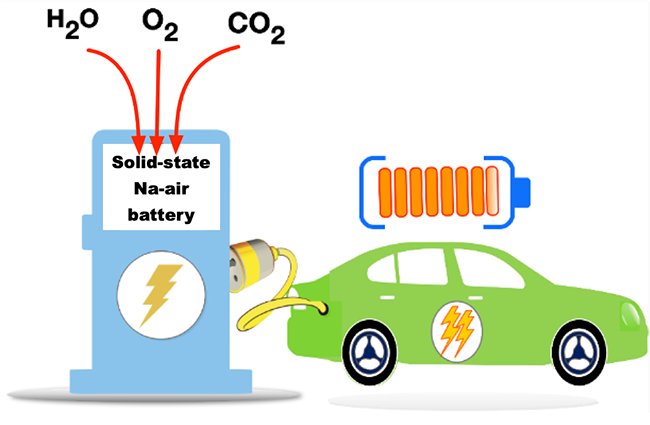A research team led by Professor Byoungwoo Kang and Dr. Heetaek Park from the Pohang University of Science and Technology has developed a high-energy, highly efficient, all-solid-state sodium-air battery. This battery has the ability to reversibly use air and sodium without the need for any additional equipment. This study was published in the journal Nature Communications.
 Illustration depicting an electric vehicle charging station powered by high-energy, high-efficiency all-solid-state sodium-air cells. Image Credit: Pohang University of Science and Technology
Illustration depicting an electric vehicle charging station powered by high-energy, high-efficiency all-solid-state sodium-air cells. Image Credit: Pohang University of Science and Technology
Secondary batteries are crucial for green technologies, including electric vehicles and energy storage systems. The emerging "metal-air batteries," which harness the abundant earthly resources of metals and oxygen, represent the next step in high-capacity energy storage.
However, these batteries face efficiency losses due to the formation of carbonate, a byproduct resulting from the reaction of metal with oxygen in the presence of atmospheric CO2 and water vapor.
To mitigate this issue, metal-air batteries often require additional components, such as oxygen permeation membranes. These membranes help either purify or selectively utilize atmospheric oxygen, enhancing overall battery efficiency.
In this research, the team utilized Nasicon, a Na superionic conductor and solid electrolyte, to effectively address the carbonate issue.
Nasicon, composed of elements such as sodium (Na), silicon (Si), and zirconium (Zr), acts as a solid electrolyte that allows ion movement in the solid state while maintaining high electrochemical and chemical stability. By leveraging this solid electrolyte, the team protected sodium metal electrodes from exposure to air and facilitated the breakdown of carbonate formed during electrochemical cell operation.
Consequently, the reversible electrochemical reaction involving carbonate increased the cell’s energy density by raising the working voltage and significantly reducing the voltage gap during charging and discharging, thereby enhancing energy efficiency.
Moreover, the team’s all-solid-state sodium-air cell demonstrated superior kinetic capability through an in-situ formed catholyte, which facilitated rapid sodium ion conduction within the electrode. Remarkably, the cell operated solely on metal and air without the need for additional oxygen filtration equipment.
We have devised a method to harness carbonate, a longstanding challenge in the development of high-energy metal-air batteries, we hope to lead the field of the next generation all-solid-state metal-air batteries, leveraging a solid electrolyte-based cell platform that remains stable in ambient conditions and offers a broad voltage range.
Byoungwoo Kang, Professor, Department of Materials Science and Engineering, Pohang University of Science and Technology
The research was conducted with support from the Mid-Career Researcher Program of the National Research Foundation of Korea and BK21(+).
Journal Reference:
Park, H., et al. (2024) Activating reversible carbonate reactions in Nasicon solid electrolyte-based Na-air battery via in-situ formed catholyte. Nature Communications. doi.org/10.1038/s41467-024-47415-0.